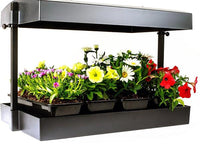If you have ever bought seeds from a seed bank or dispensary, you know that there are lots of choices these days. On the menu are auto-flowering, photoperiod, and feminized seeds plus strains that favor indoor grows, greenhouses, desired height ranges, and much more.
Here, we’ll focus on the differences between auto-flowering and photoperiod plants so you can make educated decisions about your grow.
What are Auto-flowering Strains?
Autoflowering strains are descendants of the plant ruderalis. Some botanists say the c. ruderalis is a species like indica and sativa, and others say it’s an indica subspecies and a descendent of other indica strains. Then again, botanists can’t even agree on whether indica and sativa are two different species.
The c. ruderalis is native to the northern regions of Russia, the eastern half of Europe, and parts of northern Asia. All of these places have frigid climates and short growing seasons. These conditions forced the plants to adapt by producing flowers based on age rather than changes in light exposure.
All auto-flowering strains can claim c. ruderalis as an ancestor, and they usually begin flowering after three or four weeks.
What is a Photoperiod Strain?
Photoperiod strains begin flowering in response to changing light conditions.
For indoor grow rooms, this means you must decrease the time your girls spend in the light vs darkness to get them to flower.
For outdoor grows, this means your plants will begin flowering at a point determined by natural day/night cycles.
Pros of Autoflowering Strains
Pro: More Harvests (or Continuous Harvests!) for Outdoor Grows
For most outdoor grows, switching to autoflowering strains will give you more harvests. They begin flowering sometime between days 21 and 30. The time between germination and harvest averages about three months.
It will vary by strain, but that’s the average. Strains like Quick One and Royal Dwarf are ready to harvest in two months, and this includes germination time.
Photoperiod strains are ready to harvest sometime in the autumn. It could be as early as September or as late as December. If you ask someone in Mendocino County when harvest season is, they’ll say October.
If your photoperiod seeds germinate on April 1st, you need to wait at least five months to harvest and probably six months. Autoflowering plants will be ready by 4th of July celebrations if you’re in the USA. You can start a whole new cycle then and harvest again in October. The fastest auto strains will be ready in late May or early June.
Heck, you can even skip the first cycle and start planting in the summer. Not only that, but you can also opt to start a new grow every month or two and ensure a constant bud supply for a few months.
Pro: More Versatile & Easy to Grow
These strains can grow in conditions with greater adversity on average. They’re more resistant to diseases, pests, molds, overfeeding, underfeeding, and volatile weather conditions.
Pro: Autos Won’t Be Tricked by City Lights
In an outdoor urban grow, you might have a problem shielding your photoperiod girls from artificial light. The lights may trick them into staying in the vegetative stage.
Pro & Con: Autoflowering Plants are Smaller
If you need to be stealth, or if you have a small growing space, autos tend to be smaller than conventional strains.
For example, the height of a Quick One can range from 20-24 inches indoors and 24-40 inches outdoors. Autos rarely go over 48 inches in height.
They will never be taller than you are, so they’re easier to care for as well.
Cons of Autoflowering Strains
Con: Lower Average Yield
These “dwarf” strains may be stealth, but the limited size brings limited yields. Again, this is just a matter of averages. You can find autoflowering strains with high-yield genetics.
Some Yield-Boosting Methods Won’t Work
For example, you can prolong the vegetative stage in photoperiod crops to increase the plant size and flowering yield. That won’t work with autos.
Con: Autos are Harder to Train
Autoflowering strains are very beginner-friendly, but with one catch. They grow quickly. As a result, they become more rigid more quickly.
You can still train your plants, but it’s easier to harm them in the process. This can decrease yield while the whole point of training is to increase it.
Con: You Can’t Clone Them
Cloning just doesn’t work. If you cut a chunk out of one plant, it won’t turn into another plant. You can only grow autoflowering strains from seeds.
And there you have it. These are the most notable pros and cons of autoflowering plants vs photoperiod varieties.
Talk to an Expert for Free
If you have questions about your autoflowering or photoperiod grow, nutrient needs, products, or anything else, call or text us or email us. We've made all the rookie mistakes so you don't have to.











